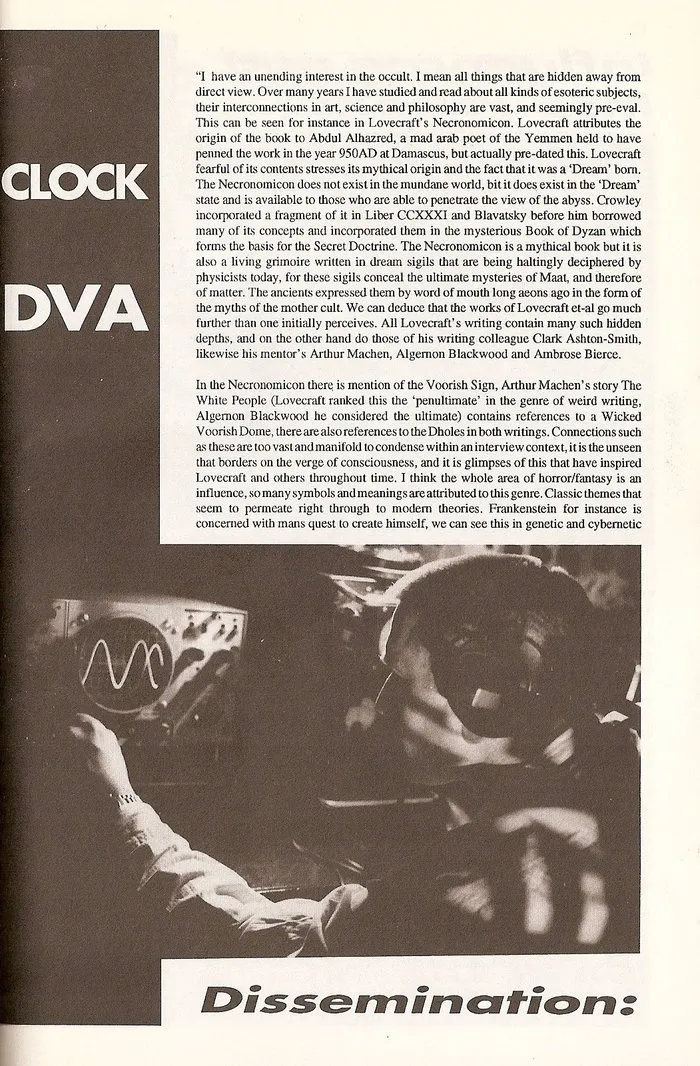Clock DVA
Dissemination: Influences and Inspirations
“I have an unending interest in the occult. I mean all things that are hidden away from direct view. Over many years I have studied and read about all kinds of esoteric subjects, their interconnections in art, science and philosophy are vast, and seemingly pre-eval.
This can be seen for instance in Lovecraft's Necronomicon. Lovecraft attributes the origin of the book to Abdul Alhazred, a mad arab poet of the Yemmen held to have penned the work in the year 9SOAD at Damascus, but actually pre-dated this. Lovecraft fearful of its contents stresses its mythical origin and the fact that it was a ‘Dream’ born.
The Necronamicon does not exist in the mundane world, bit it does exist in the ‘Dream’ state and is available to those who are able to penetrate the view of the abyss. Crowley incorporated a fragment of it in Liber CCXXXI and Blavatsky before him borrowed many of its concepts and incorporated them in the mysterious Book of Dyzan which forms the basis for the Secret Doctrine. The Necronomicon is a mythical book but it is also a living grimoire written in dream sigils that are being haltingly deciphered by physicists today, for these sigils conceal the ultimate mysteries of Maat, and therefore
of matter. The ancients expressed them by word of mouth long aeons ago in the form of the myths of the mother cult. We can deduce that the works of Lovecraft et-al go much further than one initially perceives. All Lovecraft's writing contain many such hidden depths, and on the other hand do those of his writing colleague Clark Ashton-Smith, likewise his mentor’s Arthur Machen, Algernon Blackwood and Ambrose Bierce.
In the Necronomicon there is mention of the Voorish Sign, Arthur Machen's story The White People (Lovecraft ranked this the ‘penultimate’ in the genre of weird writing, Algemon Blackwood he considered the ultimate) contains references to a Wicked Voorish Dome, there are also references to the Dholes in both writings. Connections such as these are too vast and manifold to condense within an interview context, it is the unseen that borders an the verge of consciousness, and it is glimpses of this that have inspired Lovecraft and others throughout time. I think the whole area of horror/fantasy is an influence, so many symbols and meanings are attributed to this genre. Classic themes that seem to permeate right through to modem theories. Frankenstein for instance is concerned with mans quest to create himself, we can see this in genetic and cybernetic

engineering, likewise, Stevenson's Jekyll and Hyde could be seen in the light of right/left brain experiments. Freuds ego/id ete. Sexuality also within the context of horror is a very large subject recently explored in the publication of The Dark Romance (sex and death in the horror film) and particularly in Valerian Borowcyzyk’s Doctor Jekyll et les Femmes, where the full sexuality of Hyde is unleashed in a series of psycho-sexual murders, perpetrated against men, women and children. This particular film is probably the finest example of pure derangement of the senses, and so is a fulfillment of the De-Sadian surrealist raison d'etre.
I think it is difficult and also dangerous to categorise works such as Stephen Mallarme’s lgutar or Lautreamont’s Chantes de Maldoror or J.K. Huysman’s La Bas, merely as horror, when really they encompass diverse and complex symbolic metaphysics. I have also felt a great affinity to this area from an early age, I can remember being interested in any film within this category. Films like Robert Wise's The Haunting were very influential upon me at an early age, this particular film contains strong psychological, as well as visual and sonic effects that create an intense atmosphere within the story, which is based upon a professor of parapsychology undertaking the research and recordings of extra dimensional phenomena. Films like Carl Dreyer’s Vampyre is an amazing culmination of visual ideas and surrealistic montage sequences that create new levels of perceptions. Tobe Hooper's Texas Chainsaw Massacre, Jack Taunier’s The Innocents, Valerian Borowczyk’s Doctor Jekyll et les Femmes and Werner Herzog’s Nosferatu are but a few of the films that have remained and left a strong impression”
The above forms part of an interview conducted with Adi Newton of Clock DVA. Additional, different interview material can be found in the following publications:
Fractured, Issue 3 August 1991 article was entitled Clock DVA; Energy Tending To Change and was reprinted in the American magazine Technology Works, Issue X, July, 1992. It is important to share information. What interests one might well interest the other.
-- Mathew F. Riley
